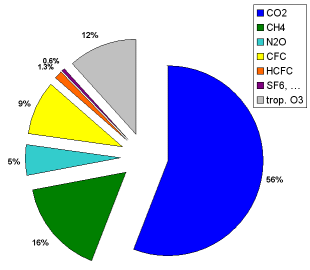Which gases contribute to the greenhouse effect?
The most important greenhouse gas is water vapour (which accounts for about 60% of the greenhouse effect) but we don't think that concentrations of water vapour in the atmosphere have changed much over the past few centuries. So its unlikely that water vapour is responsible for the observed warming of our planet. However, human activity has dramatically increased the concentration of carbon dioxide in the atmosphere, from 280 ppm in preindustrial times to 385 ppm* in 2008. Carbon dioxide is the second most important greenhouse gas in the atmosphere, contributing about 20% of the greenhouse effect. Concentrations of methane and ozone, which are also strong greenhouse gases, have also increased dramatically since the industrial revolution. Greenhouse gases are trace gases, and beside from CO2, they account for less than one millionth of the total air mass.
In some scientific publications the contribution of the greenhouse gases to the warming of the Earth is called 'radiative forcing'. It is measured in watts per square meter (W m-2). Between 1750 (when the industrial revolution started) and today, the concentrations of greenhouse gases have increased dramatically as a result of human activity. The numbers on the right show the increase in radiative forcing during this time.
* 1ppm = 1 molecule of a gas in 1 million molecules of air
|
 |
 |
 |
|
4. Contributions of the tropospheric greenhouse gases to radiative forcing between 1750 (preindustrial times) and 2005. This is a measure of the additional greenhouse effect resulting from human activity. Carbon dioxide has the greatest effect. Author: Elmar Uherek. Values from IPCC AR4 2007.
Please click to enlarge!
Radiative forcing of the additional greenhouse gases (1750 - 2000) values in W m-2.
1.46 CO2 (carbon dioxide)
0.48 CH4 (methane)
0.24 CFC 11+12 (chlorofluorocarbons)
0.35 trop. O3 (tropospheric ozone)
0.15 N2O (nitrous oxide)
|
|







